Direct Measurements of Petroleum Hydrocarbon Vapors in the Risk Assessment Procedure: The Case of a Contaminated Italian Site
Abstract
1. Introduction
2. Materials and Methods
2.1. Case Study Description and Previous Activities
2.2. Experimental Campaign for Soil Gas and Emission Flux Measurements
2.3. Human Health Risk Assessment—HHRA
3. Results
3.1. Comparison Between Soil Gas and Flux Chamber Data
3.2. Comparison Between Model and Field Data
3.3. Role of Direct Measures in Human Health Risk Assessment
4. Discussion
5. Conclusions
Author Contributions
Funding
Institutional Review Board Statement
Informed Consent Statement
Data Availability Statement
Acknowledgments
Conflicts of Interest
Abbreviations
| HHRA | Human Health Risk Assessment |
| CSM | Conceptual Site Model |
| VOCs | Volatile Organic Compounds |
| RBCA | Risk-Based Corrective Action |
| MP | Monitoring Point |
| DL | Detection Limit |
| HI | Hazard Index |
| SGS | Soil Gas Probe |
| FC | Flux Chamber |
References
- Islam, M.N.; Jung, S.K.; Jung, H.-Y.; Park, J.-H. The feasibility of recovering oil from contaminatedsoil at petroleum oil spill site using a subcriticalwater extraction technology. Process Saf. Environ. Prot. 2017, 111, 52–59. [Google Scholar] [CrossRef]
- ITRC. Petroleum Vapor Intrusion: Fundamentals of Screening, Investigation, and Management; Interstate Technology and Regulatory Council, Vapor Intrusion Team: Washington, DC, USA, 2014.
- U.S. EPA. Technical Guide for Addressing Petroleum Vapor Intrusion at Leaking Underground Storage Tank Sites; EPA 510-R-15-001; U.S. Environmental Protection Agency, Office of Underground Storage Tanks: Washington, DC, USA, 2015. Available online: http://www.epa.gov/oust/cat/pvi/pvi-guide-final-6-10-15.pdf (accessed on 7 December 2024).
- Agency for Toxic Substances and Disease Registry (ATSDR). Toxicological Profile for Total Petroleum Hydrocarbons (TPH); U.S. Department of Health and Human Services: Washington, DC, USA, 1999. Available online: https://www.atsdr.cdc.gov (accessed on 22 April 2025).
- International Agency for Research on Cancer (IARC). Benzene. IARC Monographs on the Evaluation of Carcinogenic Risks to Humans. 2018. Available online: https://monographs.iarc.who.int (accessed on 22 April 2025).
- World Health Organization (WHO). WHO Guidelines for Indoor Air Quality: Selected Pollutants. 2010. Available online: https://www.who.int/publications/i/item/9789289002134 (accessed on 22 April 2025).
- Smith, D.J.; Johnson, M.P.; Carter, H.R. Leukemia risk among petroleum refinery workers: A Cohort Study. Am. J. Ind. Med. 2022, 65, 567–579. [Google Scholar]
- Chen, D.; Werder, E.J.; Stewart, P.A.; Stenzel, M.R.; Gerr, F.E.; Lawrence, K.G.; Groth, C.P.; Huynh, T.B.; Ramachandran, G.; Banerjee, S.; et al. Exposure to volatile hydrocarbons and neurologic function among oil spill workers up to 6 years after the Deepwater Horizon disaster. Environ. Res. 2023, 231, 116069. [Google Scholar] [CrossRef] [PubMed]
- Lv, J.; Li, X.; Shen, Y.; You, J.; Wen, M.; Wang, J.; Yang, X. Assessing volatile organic compounds exposure and chronic obstructive pulmonary diseases in US adults. Front. Public Health 2023, 11, 1210136. [Google Scholar] [CrossRef]
- Legislative Decree N: 152/2006; Norme in materia ambientale (G.U. n. 88 14 aprile 2006). Istituto Poligrafico e Zecca dello Stato: Roma, Italy, 2006. (In Italian)
- ASTM. Standard Guide for Risk-Based Corrective Action, Designation: E-2081-00. 2000. Available online: https://store.astm.org/e2081-22.html (accessed on 28 April 2025).
- Davis, G.B.; Patterson, B.M.; Trefry, M.G. Evidence for instantaneous oxygen-limited biodegradation of petroleum hydrocarbon vapors in the subsurface. Groundw. Monit. Remediat. 2009, 29, 126–137. [Google Scholar] [CrossRef]
- Lahvis, M.A.; Hers, I.; Davis, R.V.; Wright, J.; DeVaull, G.E. Vapor intrusion screening at petroleum UST release sites. Groundw. Monit. Remediat. 2013, 33, 53–67. [Google Scholar] [CrossRef]
- Hers, I.; Jourabchi, P.; Lahvis, M.A.; Dahlen, P.; Luo, H.; Johnson, P.; DeVaull, G.E.; Mayer, K.U. Evaluation of seasonal factors on petroleum hydrocarbon vapor biodegradation and intrusion potential in a cold climate. Groundw. Monit. Remediat. 2014, 34, 60–78. [Google Scholar] [CrossRef]
- Verginelli, I.; Pecoraro, R.; Baciocchi, R. Using dynamic flux chambers to estimate the natural attenuation rates in the subsurface at petroleum contaminated sites. Sci. Total Environ. 2018, 619–620, 470–479. [Google Scholar] [CrossRef]
- Hers, I.; Atwater, J.; Li, L.; Zapf-Gilje, R. Evaluation of vadose zone biodegradation of BTX vapours. J. Contam. Hydrol. 2000, 46, 233–264. [Google Scholar] [CrossRef]
- DeVaull, G.E. Indoor vapor intrusion with oxygen-limited biodegradation for a subsurface gasoline source. Environ. Sci. Technol. 2007, 41, 3241–3248. [Google Scholar] [CrossRef]
- Verginelli, I.; Baciocchi, R. Vapor intrusion screening model for the evaluation of risk-based vertical exclusion distances at petroleum contaminated sites. Environ. Sci. Technol. 2014, 48, 13263–13272. [Google Scholar] [CrossRef] [PubMed]
- Yao, Y.; Wu, Y.; Wang, Y.; Verginelli, I.; Zeng, T.; Suuberg, E.M.; Jiang, L.; Wen, Y.; Ma, J. A petroleum vapor intrusion model involving upward advective soil gas flow due to methane generation. Environ. Sci. Technol. 2015, 49, 11577–11585. [Google Scholar] [CrossRef] [PubMed]
- Verginelli, I.; Capobianco, O.; Baciocchi, R. Role of the source to building lateral separation distance in petroleum vapor intrusion. J. Contam. Hydrol. 2016, 189, 58–67. [Google Scholar] [CrossRef]
- Yao, Y.; Verginelli, I.; Suuberg, E.M. A two-dimensional analytical model of petroleum vapor intrusion. Water Resour. Res. 2016, 52, 1528–1539. [Google Scholar] [CrossRef] [PubMed]
- Davis, G.B.; Knight, J.H.; Rayner, J.L. Extinguishing Petroleum Vapor Intrusion and Methane Risks for Slab-on-ground Buildings: A Simple Guide. Groundw. Monit. Remediat. 2021, 41, 61–72. [Google Scholar] [CrossRef]
- Ma, J.; Mchugh, T.; Beckley, L.; Lahvis, M.; Devaull, G.; Jiang, L. Vapor Intrusion Investigations and Decision-Making: A Critical Review. Environ. Sci. Technol. 2020, 54, 7050–7069. [Google Scholar] [CrossRef]
- Bekele, D.N.; Naidu, R.; Bowman, M.; Chadalavada, S. Vapor intrusion models for petroleum and chlorinated volatile organic compounds: Opportunities for Future Improvements. Vadose Zone J. 2013, 12, vzj2012.0048. [Google Scholar] [CrossRef]
- Almansoory, A.F.; Hasan, H.A.; Sheikh Abdullah, S.R.; Idris, M.; Anuar, N.; Al-Adiwish, W.M. Biosurfactant produced by the hydrocarbon-degrading bacteria: Characterization, Activity and Applications in Removing TPH from Contaminated Soil. Environ. Technol. Innov. 2019, 14, 100347. [Google Scholar] [CrossRef]
- Verginelli, I.; Lahvis, M.A.; Jourabchi, P.; DeVaull, G.E. Soil gas gradient method for estimating natural source zone depletion rates of LNAPL and specific chemicals of concern. Water Res. 2024, 267, 122559. [Google Scholar] [CrossRef]
- Lundegard, P.D.; Johnson, P.C. Source zone natural attenuation at petroleum hydrocarbon spill sites—II: Application to a Former Oil Field. Groundw. Monit. Remediat. 2006, 26, 93–106. [Google Scholar] [CrossRef]
- Johnson, P.C.; Lundegard, P.D.; Liu, Z. Source zone natural attenuation at petroleum hydrocarbon spill sites—I: Site-Specific Assessment Approach. Groundw. Monit. Remediat. 2006, 26, 82–92. [Google Scholar] [CrossRef]
- Molins, S.; Mayer, K.U.; Amos, R.T.; Bekins, B.A. Vadose zone attenuation of organic compounds at a crude oil spill site—Interactions Between Biogeochemical Reactions and Multicomponent Gas Transport. J. Contam. Hydrol. 2010, 112, 15–29. [Google Scholar] [CrossRef]
- McHugh, T.; Davis, R.; DeVaull, G.; Hopkins, H.; Menatti, J.; Peargin, T. Evaluation of vapor attenuation at petroleum hydrocarbon sites: Considerations for Site Screening and Investigation. Soil Sediment Contam. 2010, 19, 725–745. [Google Scholar] [CrossRef]
- Vecchio, A. Le linee guida sul monitoraggio degli aeriformi prodotte dal gruppo di lavoro 9 bis del SNPA. In Siti Contaminati: Esperienze Negli Interventi Di Risanamento; CSISA: Catania, Italy, 2019; pp. 65–79. (In Italian) [Google Scholar]
- Brummell, M.E.; Siciliano, S.D. Chapter Five—Measurement of Carbon Dioxide, Methane, Nitrous oxide, and Water Potential in Soil Ecosystems. Methods Enzymol. 2011, 496, 115–137. [Google Scholar] [CrossRef] [PubMed]
- Davidson, E.A.; Savage, K.; Verchot, L.V.; Navarro, R. Minimizing artifacts and biases in chamber-based measurements of soil respiration. Agric. For. Meteorol. 2002, 113, 21–37. [Google Scholar] [CrossRef]
- Grøndahl, L.; Friborg, T.; Christensen, T.R.; Ekberg, A.; Elberling, B.; Illeris, L.; Nordstrøm, C.; Rennermalm, Å.; Sigsgaard, C.; Søgaard, H. Spatial and Inter-Annual Variability of Trace Gas Fluxes in a Heterogeneous High-Arctic Landscape. Adv. Ecol. Res. 2008, 40, 473–498. [Google Scholar] [CrossRef]
- Pumpanen, J.; Kolari, P.; Ilvesniemi, H.; Minkkinen, K.; Vesala, T.; Niinistö, S.; Lohila, A.; Larmola, T.; Morero, M.; Pihlatie, M.; et al. Comparison of different chamber techniques for measuring soil CO2 efflux. Agric. For. Meteorol. 2004, 123, 159–176. [Google Scholar] [CrossRef]
- Eklund, B. Practical guidance for flux chamber measurements of fugitive volatile organic emission rates. J. Air Waste Manag. Assoc. 1992, 42, 1583–1591. [Google Scholar] [CrossRef]
- Ma, J.; McHugh, T.; Eklund, B. Flux chamber measurements should play a more important role in contaminated site management. Environ. Sci. Technol. 2020, 54, 11645–11647. [Google Scholar] [CrossRef]
- Saponaro, S.; Sezenna, E.; Careghini, A.; Mastorgio, A.; Spinelli, L. Open Dynamic Flux Chamber. Patent Application No. 0001427937, 29 March 2017. [Google Scholar]
- SNPA. Progettazione del monitoraggio dei vapori nei siti contaminati; Linea Guida SNPA 15/2018; SNPA: Roma, Italy, 2018; ISBN 978-88-448-0922-5. (In Italian) [Google Scholar]
- U.S. EPA. Method 5021A—Volatile Organic Compounds in Various Sample Matrices Using Equilibrium Headspace Analysis (SW-846); U.S. EPA: Washington, DC, USA, 2014; pp. 1–31.
- U.S. EPA. Method 8260C—Volatile Organic Compounds by Gas Chromatography/Mass Spectrometry (GC/MS); U.S. EPA: Washington, DC, USA, 2006; pp. 1–92.
- U.S. EPA. Method 3550C—Ultrasonic Extraction; U.S. EPA: Washington, DC, USA, 2007; p. 245.
- U.S. EPA. Method 8270D—Semivolatile Organic Compounds by Gas Chromatography/Mass Spectrometry; U.S. EPA: Washington, DC, USA, 2014; pp. 6–72.
- U.S. EPA. Method 8015C—Nonhalogenated Organics Using GC/FID; U.S. EPA: Washington, DC, USA, 2003; pp. 1–37.
- ISO 16703:2004; Soil Quality—Determination of Content of Hydrocarbon in the Range C10 to C40 by Gas Chromatography. ISO: Geneva, Switzerland, 2004.
- Verginelli, I. Risk-Net User Guide; Version 3.2; Reconnet: Rome, Italy, 2024; Available online: www.reconnet.net (accessed on 19 November 2024).
- ISPRA. Methodological Criteria for Absolute Risk Analysis Application at Contaminated Sites. Italian Environmental Protection Agency and Technical Services. 2008. Available online: www.isprambiente.gov.it (accessed on 15 December 2024). (In Italian)
- Unnithan, A.; Bekele, D.; Chadalavada, S.; Naidu, R. Insights into vapour intrusion phenomena: Current Outlook and Preferential Pathway Scenario. Sci. Total Environ. 2021, 796, 148885. [Google Scholar] [CrossRef]
- Verginelli, I. Petroleum vapor intrusion. In Advances in the Characterisation and Remediation of Sites Contaminated with Petroleum Hydrocarbons; Springer International Publishing: Cham, Switzerland, 2023; pp. 139–169. [Google Scholar]
- Provoost, J.; Reijnders, L.; Swartjes, F.; Bronders, J.; Seuntjens, P.; Lijzen, J. Accuracy of seven vapour intrusion algorithms for VOC in groundwater. J. Soils Sediments 2009, 9, 62–73. [Google Scholar] [CrossRef]
- Flintoft, L. Boost for bacterial batteries. Nat. Rev. Microbiol. 2003, 1, 88. [Google Scholar] [CrossRef]
- Fuchs, G.; Boll, M.; Heider, J. Microbial degradation of aromatic compounds—From One Strategy to Four. Nat. Rev. Microbiol. 2011, 9, 803–816. [Google Scholar] [CrossRef] [PubMed]
- Lahvis, M.A.; Baehr, A.L.; Baker, R.J. Quantification of aerobic biodegradation and volatilization rates of gasoline hydrocarbons near the water table under natural attenuation conditions. Water Resour. Res. 1999, 35, 753–765. [Google Scholar] [CrossRef]
- Roggemans, S.; Bruce, C.L.; Johnson, P.C.; Johnson, R.L. Vadose zone natural attenuation of hydrocarbon vapors: An Empirical Assessment of Soil Gas Vertical Profile Data. API Soil Groundw. Res. Bull. 2001, 15, 1–12. [Google Scholar]
- Ririe, G.T.; Sweeney, R.E.; Daugherty, S.J. A comparison of hydrocarbon vapor attenuation in the field with predictions from vapor diffusion models. Soil Sediment Contam. Int. J. 2002, 11, 529–554. [Google Scholar] [CrossRef]

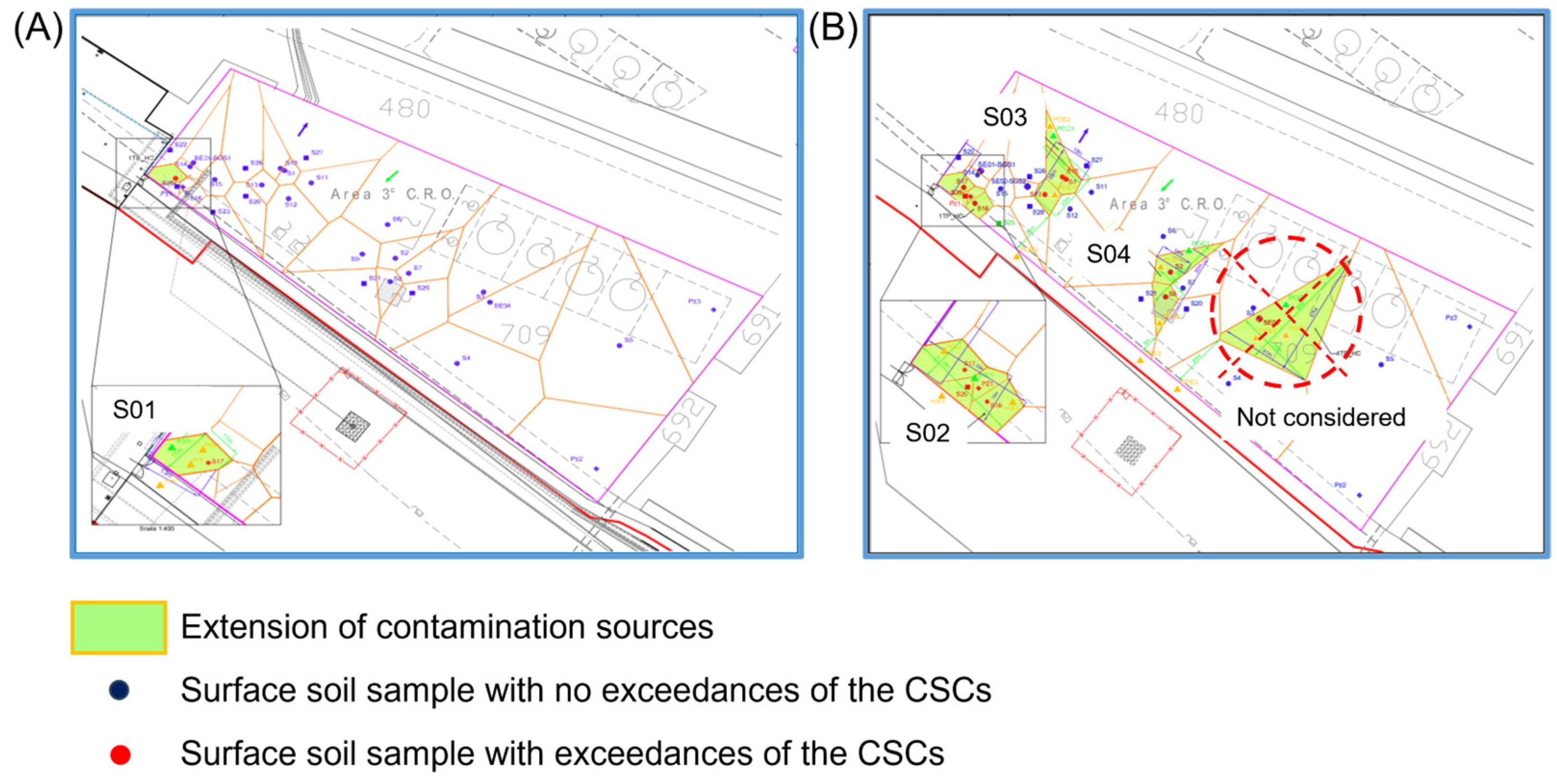
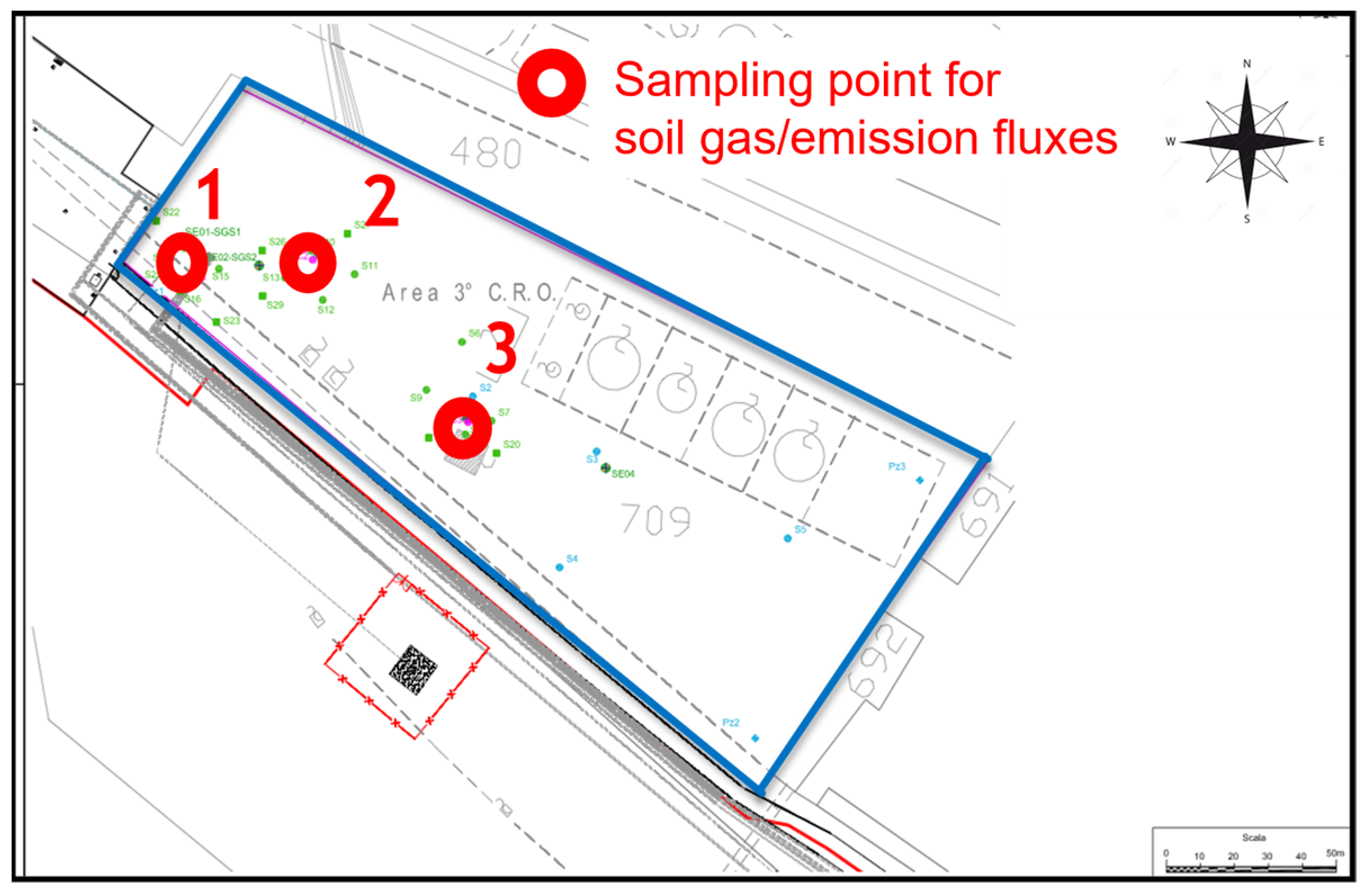
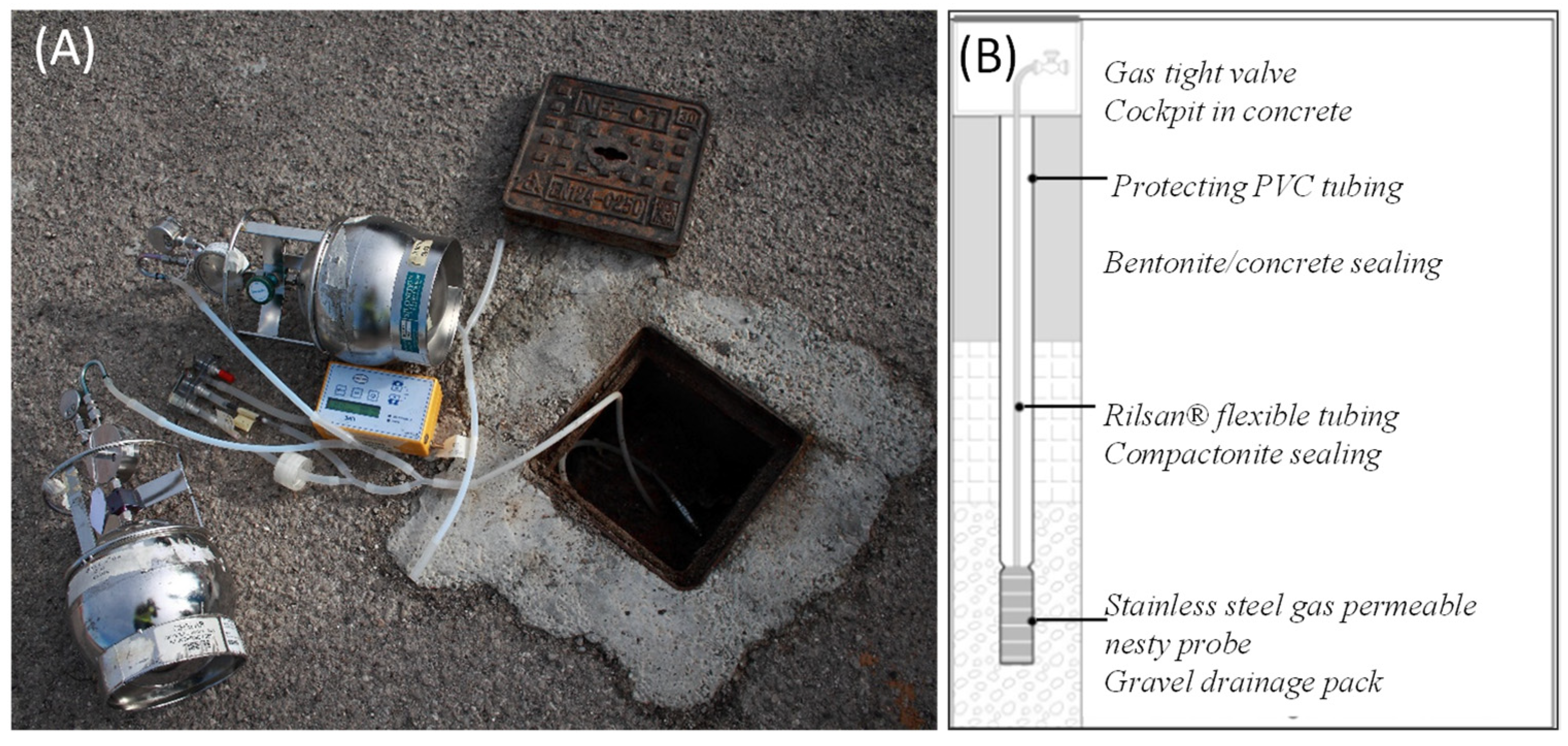
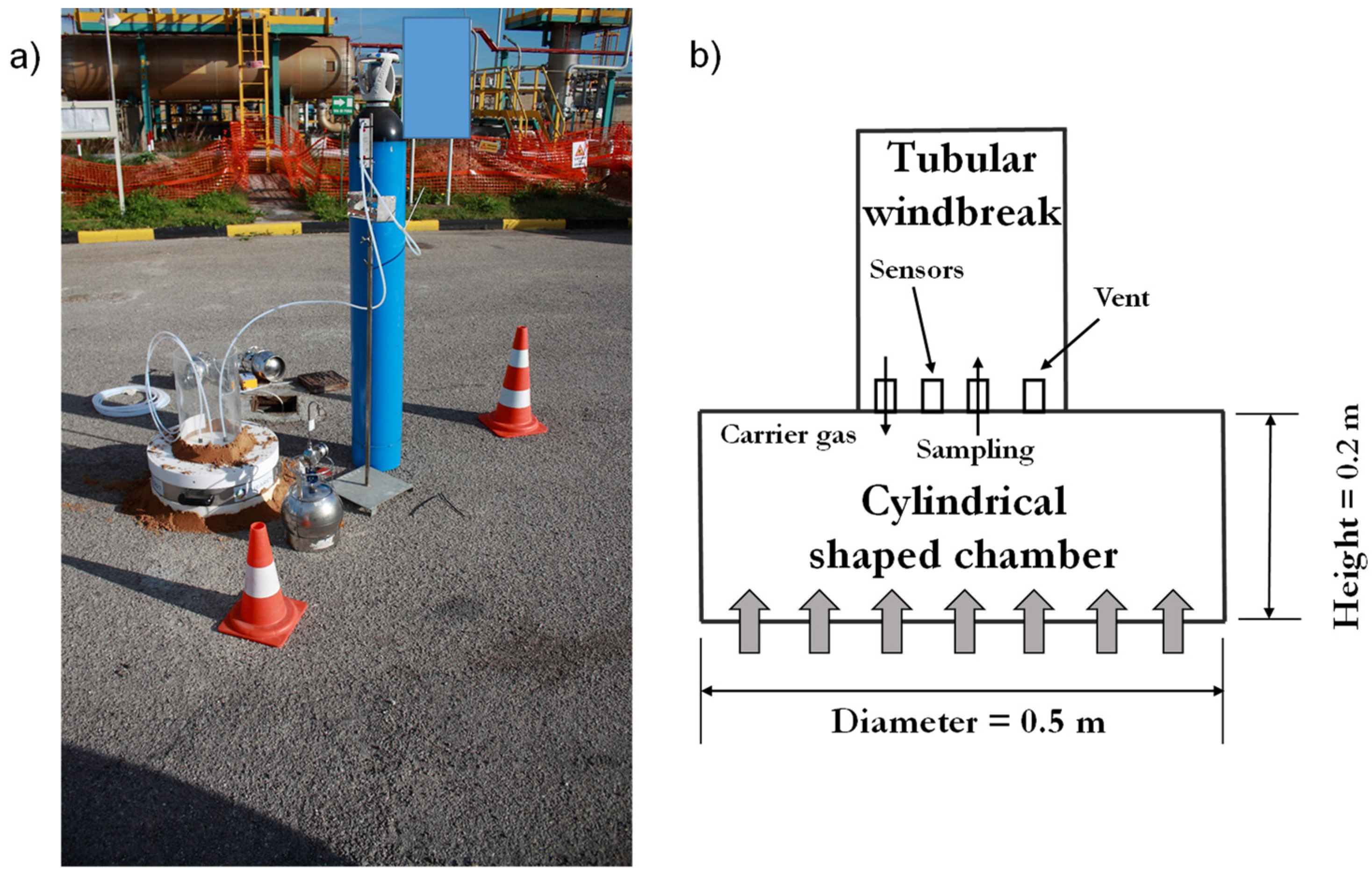
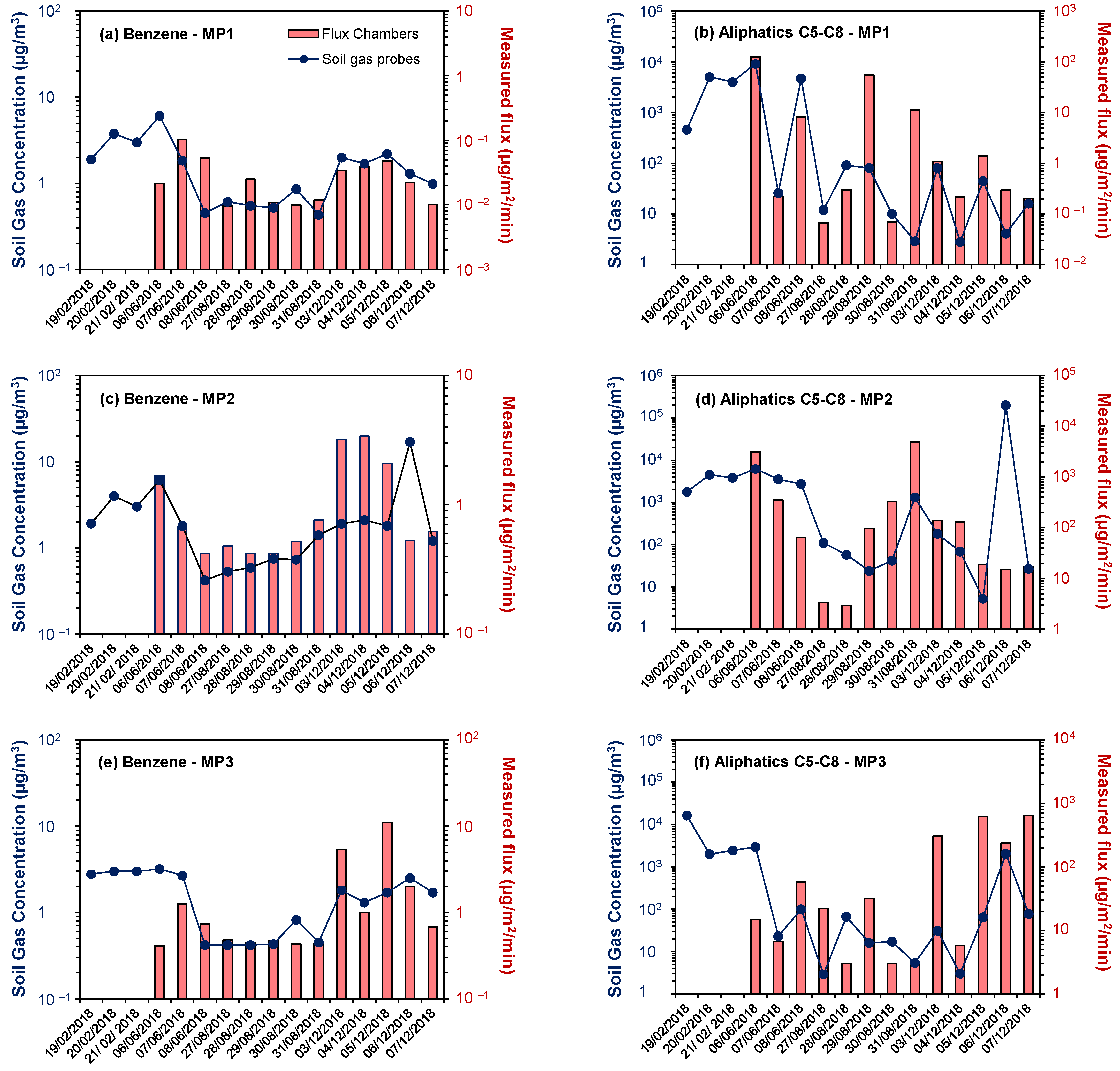

| Source | Cumulative Hazard Index Values for Total Hydrocarbons (HI) | ||
|---|---|---|---|
| Model | SGS | FC | |
| S01 | 3.1 × 10−1 | 4.6 × 10−5 | 7.9 × 10−3 |
| S02 | 3.2 × 10−1 | 2.3 × 10−4 | 8.1 × 10−3 |
| S03 | 1.3 × 10−1 | 4.5 × 10−5 | 5.2 × 10−3 |
Disclaimer/Publisher’s Note: The statements, opinions and data contained in all publications are solely those of the individual author(s) and contributor(s) and not of MDPI and/or the editor(s). MDPI and/or the editor(s) disclaim responsibility for any injury to people or property resulting from any ideas, methods, instructions or products referred to in the content. |
© 2025 by the authors. Licensee MDPI, Basel, Switzerland. This article is an open access article distributed under the terms and conditions of the Creative Commons Attribution (CC BY) license (https://creativecommons.org/licenses/by/4.0/).
Share and Cite
Di Trapani, D.; Bifulco, S.; Capodici, M.; Cosenza, A.; De Marines, F.; Farina, M.; Verginelli, I.; Viviani, G. Direct Measurements of Petroleum Hydrocarbon Vapors in the Risk Assessment Procedure: The Case of a Contaminated Italian Site. Sustainability 2025, 17, 4189. https://doi.org/10.3390/su17094189
Di Trapani D, Bifulco S, Capodici M, Cosenza A, De Marines F, Farina M, Verginelli I, Viviani G. Direct Measurements of Petroleum Hydrocarbon Vapors in the Risk Assessment Procedure: The Case of a Contaminated Italian Site. Sustainability. 2025; 17(9):4189. https://doi.org/10.3390/su17094189
Chicago/Turabian StyleDi Trapani, Daniele, Silvana Bifulco, Marco Capodici, Alida Cosenza, Federica De Marines, Marcello Farina, Iason Verginelli, and Gaspare Viviani. 2025. "Direct Measurements of Petroleum Hydrocarbon Vapors in the Risk Assessment Procedure: The Case of a Contaminated Italian Site" Sustainability 17, no. 9: 4189. https://doi.org/10.3390/su17094189
APA StyleDi Trapani, D., Bifulco, S., Capodici, M., Cosenza, A., De Marines, F., Farina, M., Verginelli, I., & Viviani, G. (2025). Direct Measurements of Petroleum Hydrocarbon Vapors in the Risk Assessment Procedure: The Case of a Contaminated Italian Site. Sustainability, 17(9), 4189. https://doi.org/10.3390/su17094189








